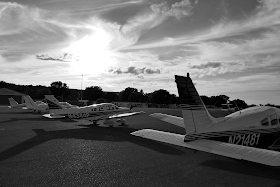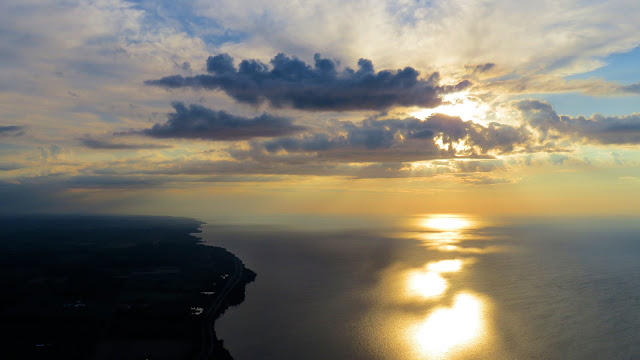Breaking Good
To appropriate the title of
Mike Busch's presentations on aircraft engine break-in, I planned to put a significant amount of time on Warrior 481's new powerplant over the weekend in hopes of finally completing break-in. Forecasts warned that it would be a hot one on Saturday, but not quite so hot as Sunday.
High pressure was forecast to dominate from western New York to Maine, so that established a plan to fly east. In short order, I fixated on Sanford Seacoast Regional Airport (KSFM) in a portion of Maine so far south that it is practically Massachusetts. The airport is positioned just east of SATAN intersection, its WWII military roots identifiable by remnants of a triangular runway configuration (it was formerly the Naval Auxiliary Air Facility Sanford). The
Pilot's Cove Cafe is right on the ramp with outdoor seating, is well-reviewed, and has lobster rolls on the menu. Sold.
| Date | Aircraft | Route of Flight | Time (hrs) | Total (hrs) |
| 18 Jul 2020 | N21481 | SDC (Sodus, NY) - SFM (Sanford, ME) - DDH (Bennington, VT) - SDC | 5.9 | 2117.6 |
Follow the Leader
The Williamson-Sodus Airport was active as I fueled Warrior 481 for the trip. A couple of members were readying N1185X for a flight; Brad, Melodie, Tom, and Alicia were setting off for Alexandria Bay; Mike was training a student in N9855W; and a transient Skyhawk from Rochester was practicing take-offs and landings.
I was amused to see the pilot of 85X wearing his ball cap backwards as he brought the Archer's engine to life. If only that hat had some useful function, like shading the pilot's eyes from the sun. Ah, well. 85X and Brad's Cirrus both took to the sky before I finished fueling.
 |
| The southern Adirondacks in the haze |
In the heat and humidity, the world was masked by ample haze. As I contacted Syracuse Approach for flight following to Sanford, I noted that 85X was directly ahead of me and flying what appeared to be the same course line. Wouldn't it be a funny coincidence if our destination was the same?
Because I was still pushing the Warrior hard to aid engine break-in, I had a 12 knot overtake on 85X and began to noticeably close the gap as we passed Griffiss. By then, it was clear that the other airplane was on a slightly divergent course from mine. I extrapolated their heading on the chart and guessed that they were bound for Glens Falls.
"November Four Eight One," called Boston Center. "You have another Cherokee, one o' clock and three miles, same altitude. He should start descending soon for Glens Falls."
Nailed it.
After hunting the sky, I finally found the minuscule dark spec against the blue carrying the other WFC members to their destination.
Rush Hour Traffic
 |
| Mount Ascutney |
After many years of flying between Laconia, NH and home, I immediately recognized the solitary profile of Mount Ascutney rising in isolation from the rolling Vermont terrain. With smooth air at 5,500 feet and little traffic, much of the flight was a trivial exercise in keeping the Warrior's nose pointed in the correct direction.
Southwest of Laconia, I was switched to Boston Approach. The frequency was busy and the controller's transmissions somewhat muddy. I tried unsuccessfully to check in for ten minutes. Despite the apparent lack of two-way communication, the Boston Approach controller called traffic to me as though we had been talking all along.
 |
| Screenshot from ForeFlight as I diverted south around Skydive Lebanon |
The next sector was easier to hear and suggested that I divert around Skydive Lebanon because of active jumping. I diverted south, noting the swarm of traffic clustered around SATAN intersection and Sanford. "Cherokee Four Eight One, I've got eight targets around Sanford," Boston Approach warned. In addition to Sanford arrivals, I maneuvered to avoid the Skydive Lebanon jump plane that was rapidly clawing its way up to altitude with a load of meat missiles on board. There were also two departures out of Sanford that were actively climbing directly at me. I have gone months without seeing other airplanes in the sky near mine and, suddenly, the airspace around me seemed to explode with them.
I maneuvered southeast of the field to allow the pattern to clear while setting up for a 45° pattern entry for runway 25. While I was on downwind, an aircraft inexplicably stopped on the runway, forcing a landing Skylane to go around. There is nothing like a little aeronautical chaos to get a pilot's blood flowing again.
 |
| ForeFlight ground track from Sodus, NY to Sanford, ME |
Lobstah
The ramp at Sanford (airport # 203) was inexplicably full except for the main portion of the ramp that was cordoned off with orange cones. My calls for parking advice to Southern Maine Aviation went unanswered. I found space -- the last space, as far as I could tell -- at the end of a line of tie downs.
After parking, I queried a lineman about my choice of parking. "Pretty busy, huh?!" he exclaimed over the whine of a jet engine. "It's nuts today. We've got so many jets coming in that we've got the whole ramp reserved. You're just fine where you are."
 |
| View from my lunch table. Maybe I should have stood up to take the picture? Yeah. Definitely. |
"Just here for lunch? No worries, no fees, you're all set!" commented the woman at the counter in Southern Maine Aviation.
Fortunately, Pilot's Cove Cafe had plenty of outdoor seating available and I chose a shaded table next to the fence separating diners from parked aircraft. The shriek of twin turbines from a jet taxiing off the ramp (above) lent more aeronautical ambiance than I would have preferred, but it goes with the territory. A cool breeze grappled with the umbrella shading my table, but offset the 91°F temperature of the day. Like a complete tourist, I ordered the overpriced lobster roll.
While I waited for lunch, a pair of sky divers landed under canopy in the grass beyond the ramp. So there was free entertainment at Sanford, too (in addition to the go-around).
I eyed the activity around the self-serve fuel pump. While I ate, multiple aircraft were blocking it and I found the $4.75/gal price to be unappetizing. (Isn't everything compared to lobster?) In that moment, I decided to stop elsewhere for fuel. I searched ForeFlight along the route home and found Morse State Airport in Bennington, VT. It was 1.3 hours west of Sanford, positioned in the southern portion of the Green Mountains where New York, Massachusetts, and Vermont join together. At $3.63/gal, it boasted one of the best aviation fuel prices in the northeast. Additionally, the airport was positively reviewed in ForeFlight and new to me.
Feet Wet
Back at Warrior 481, I verified that I had enough fuel to reach Morse State. I had about 2.3 hours on board, which would allow me to land with exactly my self-imposed one hour reserve. But first, I wanted to fly out over the Atlantic Ocean and explore a portion of the shoreline.
I was surprised by how turbulent the air was near and over the ocean. Usually, nearby bodies of water shut down thermal activity. Not so along this portion of the Atlantic seaboard. Nonetheless, I explored along the ocean as rising columns of air jostled the Warrior uncomfortably. Each jolt was preternaturally well-timed with each attempted press of my camera's shutter button.
Southern Maine never struck me as much of a beach hot spot, but Ogunquit Beach was absolutely packed with people.
Unlike the rocky coast so characteristic of northern Maine, sandy barrier islands were present reminiscent of those found much farther south.
After tiring of being shaken and rattled at 3,000 feet, I turned west, made an intentionally shallow climb to 8,500 feet to clear clouds over the mountains, and contacted Boston Approach for flight following to Morse State.
 |
| ForeFlight ground track from Sanford, ME to Bennington, VT |
At 8,500 feet, I operated at wide-open throttle with the mixture leaned to keep the propeller RPM from reaching red line. At this setting, the engine ran smoothly with remarkably low CHTs while my true airspeed surpassed 130 knots.
I changed course a few times to avoid cloud build ups and to manage my descent into mountainous terrain surrounding Morse State. As I turned final from a right pattern to runway 31, I was captivated by a pristine runway set on a plateau among the modest green mountains of southwest Vermont. It was a positively idyllic setting for an airport. I wish I had a photograph of the approach; the image in my mind's eye will have to suffice.
Fuel Stop
Aside from exceptionally aggressive vegetation growing through the ramp, the facility in Bennington was well appointed (airport # 204) in addition to offering inexpensive fuel. I took advantage of the FBO air conditioning to catch up on my email before returning to the sky.
As I waited to depart, a Cessna 150 made a very respectable short field landing and I keyed the mic to offer my opinion.
"My student thanks you!" the instructor transmitted back and I could hear the smile in his voice.
21 Hours SMOH
The flight home was a by the numbers direct flight in the late afternoon thermal chop of summer. I helped Albany Approach relay some information to a wayward pilot in another Cherokee, but otherwise the time passed unremarkably.
Bumping along, I monitored the cylinder head temperatures. A full day of flying had depressed them further since the last flight. Northwest of Syracuse, I descended to 3,000 feet and set power for the aggressive 120 knots indicated airspeed that I have been using for most of my break-in flights. The front cylinders were running in the low 370°F range and the rear were 15-20°F hotter, representing a 20-35°F drop from the original head temperatures I observed while orbiting Dansville on the first flight.
Closer to home, I pulled the power back to a normal 75% power cruise setting and watched the temperatures fall right back into the ranges I expected for my old engine on such a hot day, about 355-360°F on the front cylinders, 380°F on #3, and 370°F on #4. I still need to check my oil consumption rate, which needs to be done cold, but I think I may be nearly done with break-in.
And when that is done and I have flown my Penn Yan warranty-mandated 30 hours of constant power flying, it will be time to get my instrument currency back.




























































